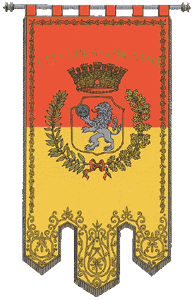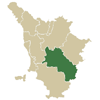|  Inhabitants in 1991: 6.956
Inhabitants in 1991: 6.956
 The
municipal territory of San Gimignano extends for 138,83 square kilometres
on the hills of the Val d’Esla. Village on the Via Francigena, then
castle, then free municipality, it became Seat of Community in 1776. The
municipal territory of San Gimignano extends for 138,83 square kilometres
on the hills of the Val d’Esla. Village on the Via Francigena, then
castle, then free municipality, it became Seat of Community in 1776.
Recorded for the first time in 929 in an act of donation by King
Ugo di Povenza to the Bishop of Volterra, who had jurisdiction on the
whole territory, San Gimignano was at that time a modest village
on the Via Francigena, but destined to become the most important
stopping place on the Medieval thoroughfare, on the tract which connected
Lucca to Siena; thus a few decades later it was already surrounded
by walls, and the Volterra Bishops promoted its development by affirming
its rights on the little rural Noble group of the surrounding area. Towards
the middle of the XII century the inhabitants of the castle, which from
1147 governed the municipality with a consul government. By now tending
to have progressive liberation from the Episcopal domination, with growing
acts of insubordination which went on for more than a century and which
showed how the dependence on the Volterra Bishop became only a formality
from the middle of the 1200s; at the same time San Gimignano proceeded
with a politics which aimed at the subjection to the local Lords and the
nearby castles from Casaglia to Montignoso, from Fosci to Catignano, in
competition with the also interested municipalities of Colle, Poggibonsi
and above all Volterra. Around the end of the third decade of the 1200s
the expansionistic aim of San Gimignano was pointed towards Gambassi,
which was a possession of the Volterra Diocese but the war broke out
between Siena and Poggibonsi on one side and Firenze and Orvieto on the
other and it was forced to choose an alliance: the choice fell
on Firenze who from that moment played a prominent part in the
political events of San Gimignano.
Divided in districts, the municipality from 1239 to 1251 saw the supremacy
of the Ghibelline, in 1252 the Guelfo-popolare government was affirmed
but after Montaperti they were dethroned while the major exponents of
local Guelfism were forced to exile. With their readmission in the city
after the undoing of the Svevi people, the Guelfa leagues again had the
supremacy, sanctioned by the vow of loyalty to Carlo d’Angio made
by San Gimignano in 1267 and by the now constant appearance of the League
of the Toscana Guilfe Municipalities; but it also reached a period earmarked
by a sort of pacific coexistence by the parties which contributed to make
the government of the municipality stable and active: evident signs
of this laborious well being are the notable architectural realisations,
from the construction of a new surrounding wall to the building of the
Town Hall, while the San Gimignano merchants increased trade both
regionally (above all with Pisa and Firenze) and towards southern Italy
and the Levante, and constructed solid turreted dwellings.
The town government, trusted from 1270 to the magistrature of the “VIII
della spesa” (eight magistrates) passed with the reform of 1301
to the college of the ”X defenders”, accenting the characteristic
of peoples government. But a new war with Volterra (1307-1309) and the
disputes between the major families (in particular between the Salvucci
and the Ardinghelli) from the end of the 1200s there was continual
interference by Firenze, who to an ever more unavoidable political
and military protection added, in the first decade of the 1300s, a significant
economic penetration by private Fiorentini with the acquisition
of land in the little district, and the more frequent resorting by the
municipality to the Firenze lenders.
After a growth of episodes which formally and substantially forebode
the submission, in 1353 San Gimignano was subjected to Firenze
with a spontaneous deliberation by their Council, having the advantage
of obtaining honourable pacts of submission, with which however Firenze
reached, without force, another important objective in the process of
annexation from central Toscana. After the years of growth their followed
the years of regression which were in the first place demographic:
the territory’s population which at the beginning of the 1300s would
have been nearly 13,000 decreased in 1350 to less than 4,000 between the
urban centre and the district, caused by the grave plague epidemic,
and was even more diminished in 1427 (3,138 inhabitants), between recurring
epidemics and economic stagnation there were no signs of appreciable recovery
until 1700, except for certain decades in the second half of the XV century.
In the Fiorentino State the people of San Gimignano lived as obedient
subjects, particularly tied to the Medicea lineage , while its reduced
management class continued for the most part to be made up of descendants
of the emerging families of the golden period between the 1200s and the
first 1300s (Salvucci, Useppi, Moronti, Braccieri and Abbracciabeni).
With the Leopoldina reforms of 1772 it became Vicariate Seat, but
in 1784 returned to being a simple Podesta office, and an equivalent event
happened several decades later: raised to Viacriate in 1846, in 1850 it
was reduced to simple Civil Magistrate. Among the illustrious born
in San Gimignano, are the poet Folgore (XIII-XIV cen.)and Curzio
da Picchena, politician and man of letters (1553-1626).
 San Gimignano first developed as an agricultural market
town, but this activity was gradually superseded in terms of economic
importance by trade and commerce. As a symbol of the town's power,
tall towers and tower-houses were erected by the local aristocracy
- in the 14th century there were 72, of which 13 are still standing -
inside the town walls; these walls, still intact today, enclose the old
quarters of San Matteo and San Giovanni. The town is one of the best
examples of medieval Tuscan urban design.
San Gimignano is well-known for the production of wine
Vernaccia. This is one of the most well-known white wines in Italy;
golden yellow in colour and with a rich bouquet, it is suitable as an
aperitif and also goes well with fish dishes. This wine has very ancient
origins, and there are records of it dating back to the 13th century.
Besides traditional Sienese sweets like panforte and ricciarelli,
the city also has one of its own, pinolata, which is made with
cream custard and pine nuts.
In the appropriate season there are also dishes made from tasty mushrooms
and aromatic truffles gathered from the nearby hills.
Places to visit:
Porta S. Giovanni, the Southern gate of the city. It is the
most beautiful gate of the ancient and intact walls from the 1200s.
Piazza della Cisterna, triangular in form, slightly sloping,
it has a brick herringbone surface. The important ancient palaces
face onto it, among which Palazzo Razzi and Palazzo Tortoli with the
cut off tower.
Torri degli Ardinghelli, 1200s twin towers erected by the same
name family of merchants.
Palazzo del Podestà severe 1200s construction dominated
by the Rognosa, one of the highest towers (52m) still intact
today.
Palazzo del Popolo, Municipal Seat, faces on Piazza del Duomo.
On the right soars the Torre Grossa (54m) from the 1300s. On
the left opens a big 1300s loggia. The Palace hosts the Civic Museum
where among the innumerable works of art exhibited there is an extremely
rare carpet of XIV century in the form of a cross.
Museum of Sacred Art, collection of works of art and objects
from the Cathedral and the churches from the San Gimignano territory.
Cathedral, basilica-collegiate dedicated to S, Maria Assunta,
it was constructed around 1050 and consecrated in 1148: in Romanic
style on a flight of steps dominating the Piazza del Duomo. The three
nave interior was enlarged in 1460 by Giuliano da Maiano, who also
constructed the famous S. Fina chapel, refined altar-tomb finely frescoed
by Ghirlandaio.
S. Agostino, church completed in 1298 of Romanic Gothic form,
dominates the same name piazza from the top of a flight of steps.
The interior of the church preserves works by Benozzo Gozzoli and
Pietro Pollaiolo. |
Historical info reproduced upon authorization of
Regione Toscana - Dipartimento della Presidenza E Affari Legislativi e
Giuridici
Translated by Ann Mountford
Picture by Sandro Santioli |